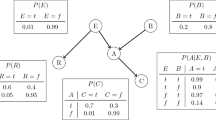Abstract
We briefly review the basic concepts underpinning the adaptive processing of data structures as outlined in [3]. Then, turning to practical applications of this framework, we argue that stationarity of the computational model is not always desirable. For this reason we introduce very briefly our idea on how a priori knowledge on the domain can be expressed in a graphical form, allowing the formal specification of perhaps very complex (i.e., non-stationary) requirements for the structured domain to be treated by a neural network or Bayesian approach. The advantage of the proposed approach is the systematicity in the specification of both the topology and learning propagation of the adopted computational model (i.e., either neural or probabilistic, or even hybrid by combining both of them).
Preview
Unable to display preview. Download preview PDF.
Similar content being viewed by others
References
Bianucci, A.M., Micheli, A., Sperduti, A., Starita, A.: Quantitative structure- activity relationships of benzodiazepines by recursive cascade correlation. In: IEEE International Joint Conference on Neural Networks, pp. 117–122 (1998)
Diligenti, M., Gori, M., Maggini, M., Martinelli, E.: Adaptive graphical pattern recognition: the joint role of structure and learning. In: Proceedings of the International Conference on Advances in Pattern Recognition, pp. 425–432. Springer, Heidelberg (1998)
Frasconi, P., Gori, M., Sperduti, A.: A framework for adaptive data structures processing. IEEE Transactions on Neural Networks 9(5), 768–786 (1998)
Fu, K.S.: Syntactic Pattern Recognition and Applications. Prentice-Hall, Englewood Cliffs (1982)
Gonzalez, R.C., Thomason, M.G.: Syntactic Pattern Recognition. Addison Wesley, Reading (1978)
Hinton, G.E.: Mapping part-whole hierarchies into connectionist networks. Artificial Intelligence 46, 47–75 (1990)
Muggleton, S., De Raedt, L.: Inductive logic programming: Theory and methods. Journal of Logic Programming 19(20), 629–679 (1994)
Pavlidis, T.: Structural Pattern Recognition. Springer, Heidelberg (1977)
Plate, T.A.: Plate. Holographic reduced representations. IEEE Transactions on Neural Networks 6(3), 623–641 (1995)
Pollack, J.B.: Recursive distributed representations. Artificial Intelligence 46(1- 2), 77–106 (1990)
Rosenfeld, R., Touretzky, D.S.: Four capacity models for coarse-coded symbol memories. Technical Report CMU-CS-87-182, Carnegie Mellon (1987)
Schalhoff, R.J.: Pattern Recognition: Statistical, Structural and Neural Approaches. John Wiley & Sons, Chichester (1992)
Smolensky, P.: Tensor product variable binding and the representation of symbolic structures in connectionist systems. Artificial Intelligence 46, 159–216 (1990)
Sperduti, A., Starita, A.: Supervised neural networks for the classification of structures. IEEE Transactions on Neural Networks 8(3), 714–735 (1997)
Touretzky, D.S.: Boltzcons: Dynamic symbol structures in a connectionist network. Artificial Intellicence 46, 5–46 (1990)
Author information
Authors and Affiliations
Editor information
Editors and Affiliations
Rights and permissions
Copyright information
© 2000 Springer-Verlag Berlin Heidelberg
About this paper
Cite this paper
Frasconi, P., Gori, M., Sperduti, A. (2000). Integration of Graphical Rules with Adaptive Learning of Structured Information. In: Wermter, S., Sun, R. (eds) Hybrid Neural Systems. Hybrid Neural Systems 1998. Lecture Notes in Computer Science(), vol 1778. Springer, Berlin, Heidelberg. https://doi.org/10.1007/10719871_15
Download citation
DOI: https://doi.org/10.1007/10719871_15
Publisher Name: Springer, Berlin, Heidelberg
Print ISBN: 978-3-540-67305-7
Online ISBN: 978-3-540-46417-4
eBook Packages: Springer Book Archive




